Why has the topic of reconstruction been so popular recently?
Konstantin Khodnev: First of all, the value of the multilayered environment is becoming more and more apparent. Second, there is a growing trend for resource saving, sustainability, and cutting the overall costs of construction and deconstruction. If we avoid tearing down this or that building, this means that we made so much for the nature conservation. This also has to do with restrictions on new construction in historical centers. Sometimes it’s easier to slightly change the building on the outside and significantly on the inside than to bury yourself in the seemingly endless process of getting all the appropriate approvals from the municipality and other public authorities.
In the 1970-1980’s, it was the usual practice to build on new lands, without having to face the challenges posed by the city. However, now that the interest for the city center is back on the scene, a question arises about what we do with the buildings that are already there, and how we can transform them to meet our new needs. The next issue is what do you do with the suburban buildings that fell into disuse. In America, for example, hundreds of shopping malls are closing down and no one knows what to do with them.
Daniel Lorentz: Our culture experiences strengthening of individualization. In addition to custom-designed clothes, we as human beings are considering an opportunity to get ourselves a custom-designed living environment: an apartment or a workplace. Today’s fashion is created by people who don’t stay in one place, who are upwardly mobile, who work from home, and who work flexible schedules. They have a different cultural vision, other points of perception. This also affects the way that historical buildings are regarded – accordingly, there are developers and architects who are ready to reconstruct them and use them as projects with new unusual properties.
Natalia Sidorova: Time leaves its individual mark, even the building materials bear the stamp of time. In fact, this is a ready resource for creating an authentic and unique atmosphere. What is also important is the fact that this is a real value, not something that was artificially invented.
Konstantin Khodnev: Perhaps, reconstruction is so attractive for this specific reason – it allows you to create some quite unexpected things that you simply couldn’t have invented in advance because of the uncertainty of your circumstances.
Natalia Sidorova: Sometimes, reconstruction allows you to use even more interesting solutions; it creates a situation where the clients are ready for new unconventional approaches and typologies. And this is how a synergy of sorts appears: both people and buildings are “ready” to deliver unusual solutions.
And are the clients prepared for that?
Daniel Lorentz: Yes, they are, and this is exactly why it has become a phenomenon. The clients are not the same as they used to be, even though you cannot say that the tables have turned completely because this is a gradual process.
Natalia Sidorova: Some are ready, some are not; with some clients you have to explain things and demonstrate the benefits of the reconstruction approaches.
Do you have your own favorite examples of high-quality interesting reconstruction projects?
Konstantin Khodnev: Let’s take the Cape Town grain elevator reconstructed by Thomas Heatherwick, which now hosts a hotel and a center of modern art – this is just the right example of what Natalia is speaking about, the example of a totally unbelievable typology and forms. Just see how its beautiful context is used, and the unique features of the old structures – a really groovy thing!

Zeitz Museum of Contemporary Art Africa © Iwan Baan
Natalia Sidorova: This cross-section of the structures allowed the architect to look at the space of the building from a totally different angle.This is not merely readjusting the building and making it perform new functions but transforming it with a modern vision that should be bold enough, and at the same time produce a stunning effect.
What we want is I think bolder, more original and more modern inclusions into the reconstructed environment.
Zeitz Museum of Contemporary Art Africa © Iwan Baan
Zeitz Museum of Contemporary Art Africa © Iwan Baan
Again, a recent example: a short while ago, we were able to visit the Kanaal by Axel Vervoordt, near Antwerpen, and it really impressed us. Unlike the acutely conceptual Heatherwick project, this one is all about creating a special atmosphere. Those concrete walls were just poured over the ground, and they became part of the landscape. The landscape design is done there by Michel Desvigne. The new construction was done by different architectural firms: so many buildings, so many authors. The buildings turned out to be different but they are still incorporated into the historical environment, and the entire complex reads like a single world with a unique atmosphere of its own. Every little detail has been taken care of.
Of course, the client played a major role here because essentially it was the client that came up with the whole concept.
Konstantin Khodnev: Yes, I agree. Continuing the topic of the role of the client, I would note the two most important reconstruction projects in this country. First of all, this is the New Holland Island, which can serve as a model example of the architects’ commitment to excellence when it comes to the material quality of reconstruction.
The New Holland Island © West 8
The New Holland Island © West 8
The second example is the Rem Koolhaas Garage, the first-ever project that reinterprets the Soviet modernist architecture. Here is the thing – when we speak reconstruction, the first thing that comes to mind is brick walls, cornices, and pitched roofs. And making a work of art from some seemingly rank-and-file buildings of modernist architecture is something that nobody did before. This was the first project of such kind. We must also note that projects like this are also few and far between in the rest of the world. And it’s also totally unique in term of the quality of execution.
Garage Museum in Gorky Park / photo courtesy by Garage
Garage Museum in Gorky Park / photo courtesy by Garage
Natalia Sidorova: And here we are speaking not just about the quality of the buildings themselves but about the quality of the atmosphere as well. When the atmosphere of the events and everything that goes on there is really connected with the building, you get the perfect environment. As a matter of fact, this is the task that we set four our educational course – teaching our students how to create such an environment.
Konstantin Khodnev: And we also want to motivate our students to think beyond the limits of squeezing a certain number of offices into a certain amount of square meters but always set for themselves a task of forming a new living environment, and making a positive difference to people’s lives. Because the meaning of any reconstruction project is for you to make it work. You need to launch a certain mechanism, every part of which matters – the architectural solutions, the program, and the ideas for further uses of this building. Essentially, a reconstruction project is about coming up with a new life.
And what kind of scenario did you come up with for “Rassvet”?
Konstantin Khodnev: There is a step-by-step process going on there; there is a fragment of environment that by degrees becomes less and less of a factory and more and more of a fragment of the city. The possibilities for development are virtually endless.
Natalia Sidorova: The two finished buildings (3.34 and 3.20) on the territory of the “Rassvet” factory became to us a very special experience of interacting with the city through deep immersion into the context. The status of redevelopment and the apartment building function allowed us to experiment with various typological solutions – the building has double-level apartments in it, including the ones that are situated on the bottom floors with individual entrances and little gardens of their own that can allow its residents to work and accept visitors on the first floor and live on the second. Today, Rassvet is full of people day and night, it functions 24/7. Cafés appeared, and new ones are being designed. The project of that territory is still developing, and we will continue working with it.
The housing complex Rassvet LOFT*Studio, Building 3.20. Photograph © DNK ag, Ilia Ivanov
What do you think are the omissions of the modern architectural education?
Natalia Sidorova: The interdisciplinary approach. It is missed by architecture in general, and by reconstruction in particular. Because of the inertia of the tradition, it is not practiced in our higher educational institutions. But here is the thing – the most interesting solutions always appear at the junction of disciplines. Hence the new program that add to the classical education. We will be trying to attract as many as possible different specialists who are proficient in architecture but who are at the same time capable of addressing non-architectural issues. There are subtleties of working with theoretical bases, and with surveying buildings, and with studying their history. There are also functional and budget issues to be addressed.
Daniel Lorentz: I would also say that when you interact not only with the terrain but also with cultural codes, this poses a challenge of a whole different level. And it’s a do-or-die battle. Either the building gets the best of you or the other was around but the happy ending is when you both survive and benefit from it.
Back to your MARCH architectural course! Was it easy for you to accept the offer and become its curators? Why was it interesting to you?
Konstantin Khodnev: I cannot say it was easy but we made a positive decision from the very start, somehow, we were quick to respond. Teaching students is hard work but it also teaches you a lot: you learn how to systematize things, how to develop your own teaching methods, how to make it all add up and form a single picture. Learn how to move on. This is all very interesting.
And, of course, it is exciting to get your knowledge and ideas that you think are important across to the maximum number of people. Because, after all, we are all looking to make a positive difference. A positive difference to the city and to people’s lives. And the more people share our values, the better.
Natalia Sidorova: I must also say that we were the residents of the first Artplay at “Red Rose”. And there was a wonderful and unique atmosphere over there back then. And now Sergey Dyatlov, the founder of Artplay, got us infected by the new venue named Pluton, where he gave us a green light in terms of working with our students. And we will be able, on the one hand, to address all the subtleties of the real redevelopment territory, and, on the other hand, maybe do some experimenting and look at things from a new angle. Try to find a few solutions that you would never have found within the framework of this or that specific client’s brief or commission. And we will have an exciting time doing this together with our students.






































